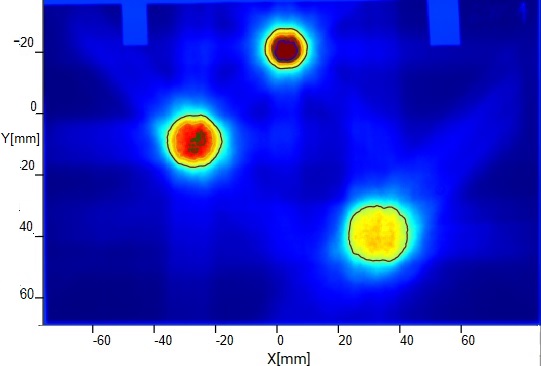End-to-end validation of stereotactic radiosurgery delivery for multiple targets
PD-0587
Abstract
End-to-end validation of stereotactic radiosurgery delivery for multiple targets
Authors: Eduard Gershkevitsh1, Borislava Petrovic2, Vivek Mahalwar3, Richard Slade-Carter4, Andrew Blackmore5, Angelos Saplaouras6
1North Estonia Medical Center, Radiotherapy, Tallinn, Estonia; 2Institute of Oncology Vojvodina, Radiotherapy, Novi Sad, Serbia; 3GenesisCare UK, Radiotherapy, London, United Kingdom; 4GenesisCare UK, Radiotherapy, Oxford, United Kingdom; 5GenesisCare UK, Radiotherapy, Southampton, United Kingdom; 6GenesisCare UK, Radiotherapy, Bristol, United Kingdom
Show Affiliations
Hide Affiliations
Purpose or Objective
The use of multiple intracranial targets irradiation with single isocenter is increasing due to potential reduction of delivery time. However, the technique requires both dosimetric and geometric accuracy verification before being implemented and as a periodic QA. The aim of the current study was to develop an end-to-end validation methodology for this technique.
Material and Methods
CIRS Shane phantom representing head and shoulder part of human anatomy was used for validation in three different clinics having the following equipment: 1. Varian Edge with Eclipse HyperArc, 2. Elekta Versa HD with BrainLab Elements, 3. Varian TrueBeam with RayStaion. All clinics used multiple non-coplanar arcs with 6FFF beam. The phantom was CT scanned and three targets (spheres with diameter 1.2, 1.6, 2.0) were created on the same coronal, but different transversal and sagittal planes (Figure 1). The centres of targets coincided with three ion chamber plugs in the phantom. The treatment plans were made to cover the targets with 80% isodose of 20, 18 and 15 Gy, respectively. The measurements were made with PTW 3D pinpoint chamber (31022) and readings were corrected with detector specific output factor correction factor following published methodology (IAEA TRS 483). For dose distribution measurements Gafchromic EBT-XD film was positioned 1 cm below the ion chamber plane and the phantom was shifted anteriorly by 1cm to have the center of the targets corresponding with the film plane. The plan was also recalculate with the shift to account for it. The phantom was positioned using CBCT imaging and 6 DOF couch in each clinic. The analyses of the film was done using IBA MyQA Patient software in multichannel mode.

Figure 1. Film showing the location of multiple targets
Results
The ion chamber measurements were within 0.2-5% of the calculated dose. The majority had the dose difference < 3%. The higher discrepancy was seen for the heavily modulated plan (HyperArc), while the lowest was seen for least modulated plan (BrainLab Elements). All films had a passing rate > 90% for 2D gamma criteria of 5%,1 mm (20% threshold).
Conclusion
The methodology was successfully tested at four clinics. It could be used as part of an audit to validate the dosimetric and geometric accuracy of multiple targets stereotactic dose delivery. 1 mm distance to agreement criteria is very sensitive to any misalignment, while 5% dose difference criteria allows for uncertainty of the film and small field ion chamber measurements.